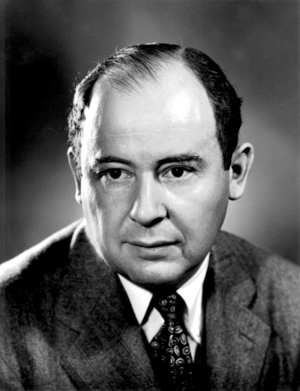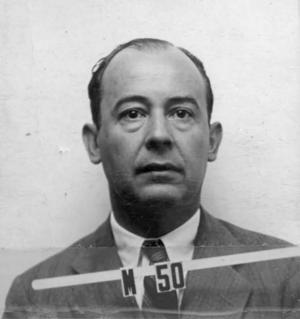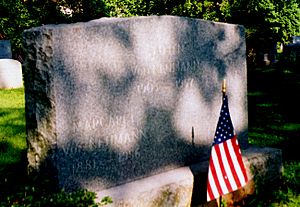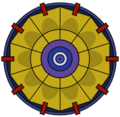John von Neumann facts for kids
Quick facts for kids
John von Neumann
|
|
|---|---|

John von Neumann in the 1940s
|
|
| Born | December 28, 1903 |
| Died | February 8, 1957 (aged 53) |
| Nationality | Hungarian, American |
| Scientific career | |
| Fields | Mathematics |
John von Neumann (born December 28, 1903 – died February 8, 1957) was a brilliant Hungarian-American mathematician and physicist. He made huge contributions to many different areas of science, including:
- Set theory (how to group things)
- Functional analysis (a part of math dealing with functions)
- Quantum mechanics (the science of very small particles)
- Ergodic theory (about systems that change over time)
- Continuous geometry (a type of geometry)
- Economics (how money and resources work)
- Game theory (how people make decisions in competitive situations)
- Computer science (how computers work)
- Numerical analysis (using math to solve problems with numbers)
- Systems theory (how different parts of a system work together)
- Statistics (collecting and analyzing data)
Many people think he was a child genius and a polymath (someone who knows a lot about many different subjects). He is seen as one of the most important mathematicians of the 20th century.
He was part of a group called the 'Martians'. These were famous Hungarian scientists, mostly physicists and mathematicians, who moved to the United States in the early 1900s. Other famous 'Martians' included Edward Teller, Paul Erdős, Leó Szilárd, and Eugene Wigner.
Contents
Early Life and Education
John von Neumann was born in Budapest, Kingdom of Hungary (which was part of the Austro-Hungarian Empire at the time), on December 28, 1903. He came from a wealthy Jewish family.
He was the oldest of three brothers. His father, Max von Neumann, was a banker and had a law degree. His mother was Margaret Kann. In 1913, the Emperor Franz Joseph made John's father a Hungarian nobleman because of his service to the empire.
Von Neumann was a true child prodigy. When he was just six years old, he could divide two eight-digit numbers in his head! He could also speak Ancient Greek. Once, when he saw his mother staring blankly, he asked her, "What are you calculating?"
When John and his brothers were young, they had private teachers. Their father believed that knowing many languages was important. So, the children learned English, French, German, and Italian. By age eight, von Neumann understood differential and integral calculus. By twelve, he had read and understood a complex math book called Théorie des Fonctions. He also loved history and read a 46-volume world history series. His family even turned one room in their apartment into a library with bookshelves from floor to ceiling.
In 1914, von Neumann started attending the Lutheran Fasori Gimnázium school.
Even though his father wanted him to stay in school with kids his own age, he agreed to hire tutors for advanced lessons. At 15, John began studying advanced calculus with a famous mathematician named Gábor Szegő. He got top grades in almost all his subjects. By the time he was 19, von Neumann had published two important math papers. One of them gave the modern definition of ordinal numbers. After finishing school, he won the Eötvös Prize, a national award for mathematics.
His friend Theodore von Kármán said that von Neumann's father wanted him to work in business. But John and his father decided that chemical engineering was a good career path. Von Neumann didn't know much about it, so he took a two-year chemistry course at the University of Berlin. Then, in 1923, he passed the entrance exam for ETH Zurich. At the same time, he also started studying for a Ph.D. in mathematics at Pázmány Péter University in Budapest.
He finished his chemical engineering degree from ETH Zurich in 1926. He also passed his final Ph.D. exams in mathematics with the highest honors, at the same time as his engineering degree! After that, he went to the University of Göttingen on a grant to study mathematics with David Hilbert.
Career and Personal Life

In 1927, von Neumann became a lecturer at the University of Berlin. He was the youngest person ever to get this position at the university. He started writing almost one major math paper every month! In 1929, he lectured briefly at the University of Hamburg. Then, in October 1929, he moved to Princeton University in the United States as a visiting lecturer in mathematical physics.
In 1930, von Neumann married Marietta Kövesi. They had a daughter named Marina in 1935. Marina is now a respected professor at the University of Michigan. John and Marietta divorced in 1937. In 1938, von Neumann married Klara Dan.
In 1933, von Neumann became a permanent professor at the Institute for Advanced Study in New Jersey. His mother, brothers, and other family members followed him to the United States in 1939. John changed his first name to John, keeping the "von Neumann" part. His brothers changed their last names to "Neumann" and "Vonneumann." He became a U.S. citizen in 1937. He even tried to join the U.S. Army Reserve, but he was too old.
He was known for always being happy to help others with their science and math problems. He would give advice to many scientists and mathematicians.
Klara and John von Neumann were very social in their community. Their house in Princeton was one of the biggest private homes. John always wore formal suits, even when riding a mule down the Grand Canyon! He loved ancient history and knew a lot about it. He also enjoyed Yiddish and funny jokes. He didn't smoke. In Princeton, people sometimes complained because he played very loud German march music on his phonograph. But von Neumann often did his best work in noisy places, even with his wife's music playing loudly. A friend said he could party late into the night and still give a clear lecture at 8:30 AM.
His daughter wrote that he cared a lot about his legacy. This meant how his life would be remembered and how his ideas would help the world.
He kept up his language skills from when he was young. He spoke Hungarian, French, German, and English fluently. He could also have conversations in Italian, Yiddish, Latin, and Ancient Greek. He loved reading Ancient Greek historians like Thucydides and Herodotus in their original language. His friend Ulam thought this might have shaped his ideas about how future events might happen and how people and society work.
Von Neumann's closest friend in the U.S. was the mathematician Ulam. Von Neumann believed that many of his math ideas came to him through intuition. He would often go to sleep with a problem unsolved and wake up knowing the answer.
Illness and Death
John von Neumann died on February 8, 1957, from cancer. He was buried at Princeton Cemetery in Princeton, New Jersey.
Amazing Work and Contributions
John von Neumann made many important contributions that still affect us today:
- His textbook on quantum mechanics was one of the first and most important books on this topic.
- His work on game theory is a key tool in business and science. It helps understand how people make choices when they are competing.
- He designed the Von-Neumann architecture. This is the basic design for almost all computers, tablets, and phones we use today!
- He was one of the first people to talk about artificial intelligence (AI). He suggested the idea of machines that could build copies of themselves. That's why a machine that can self-replicate is sometimes called a 'Von Neumann machine'.
- With Stanislav Ulam, he did very important calculations for the Manhattan Project. This was a secret project during World War II to build the first atomic bombs.
- He worked at the Institute for Advanced Study at the same time as other famous scientists like Albert Einstein, Kurt Gödel, and J. Robert Oppenheimer.
- His ideas and principles are found in every modern computer, tablet, or phone you use.
Images for kids
-
A Flow chart from von Neumann's paper about planning and coding for an electronic computing instrument, published in 1947.
See also
 In Spanish: John von Neumann para niños
In Spanish: John von Neumann para niños










